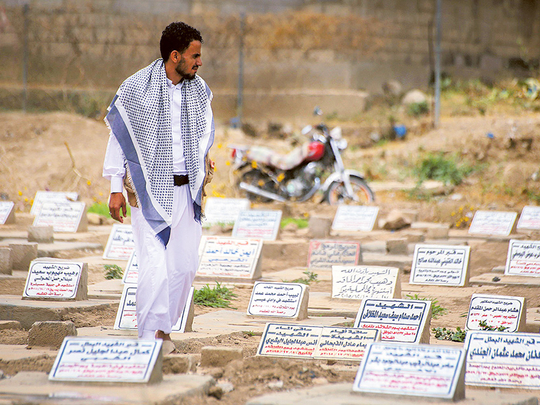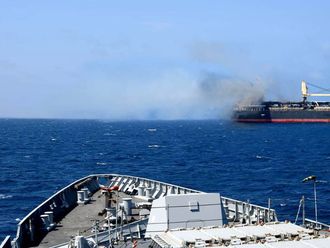
Taiz, Yemen: The streets are eerily silent in this front-line enclave near Freedom Square, where thousands of protesters rose up against the government of Ali Abdullah Saleh five years ago.
The presidential palace nearby survived the demonstrations but not the war that followed. It is now a concrete carcass, pummeled by air strikes. Shops are shuttered and homes are empty. The only people who remain cannot afford to go anywhere else.
By day, snipers strike down residents. At night, the gunfire and artillery shelling start.
Moktar Mohammad Saif in a hospital bed in Taiz, Yemen. On June 3, Doctors Without Borders received 122 wounded. The Washington Post
“We’re trapped by all sides,” said Gulam Sayed, a former bus driver.
For weeks, Yemen’s warring factions have held peace talks to end their 16-month civil war, bringing a sense of calm to much of the country. But in the southwestern city of Taiz the conflict rages on, defying a UN-backed ceasefire. Civilians are indiscriminately killed or wounded daily. Thousands languish in ragged displacement camps. Humanitarian groups are blocked from adequately helping victims.
On one side of the war is an alliance of Iran-backed Al Houthi militia and loyalists of ousted president Ali Abdullah Saleh.
People with amputated legs are pictured at a prosthetic limbs centre in southwestern city of Taiz, Yemen, on May 16. Reuters
They have seized the capital, Sana’a, and control the northern half of the country.
On the other side is the government, backed by the United States, Saudi Arabia and other regional powers. It controls only portions of the south, including the port of Aden. The rest is lawless or ruled by radical Islamists.
Sayed’s five brothers all live in this city. But he hasn’t seen them in eight months. To visit their homes, he would have to cross the front lines, dodge airstrikes or shelling and pass through a web of checkpoints controlled by rival armed groups. And that is if he manages to get out of his neighbourhood unharmed.
On a barricaded road near his building, snipers recently shot several residents at a traffic circle. On another road, cars and motorcycles speed to avoid entering the gunmen’s sights.
When his 9-year-old nephew was killed by a rocket, Sayed could not attend his funeral.
“What wrongs have the people of Taiz done to deserve all this?” he said.
Hope lost
Since the conflict began, more than 3,500 civilians in Yemen have been killed and 6,200 wounded, according to the Office of the UN High Commissioner for Human Rights. Nearly a third of those killed and maimed are children, the largest number occurring in Taiz.
The victims include 9-year-old Rowaida Qayed and 13-year-old Mohammad Badr. Rowaida was injured by an artillery shell as she fetched water from an outdoor tank. Mohammad was hit by fragments from an airstrike as he walked home.
Today, Rowaida is in a hospital bed, her right thigh filled with shrapnel. Mohammad is in a wheelchair, his legs twisted out of shape.
“I miss not being able to play outside,” Mohammad said.
“We can’t sleep at night because of the Katyusha rockets,” Murad Al-Khalafy said.
Since the siege began, prices have skyrocketed. As in most areas, there is no electricity and streets are piled with garbage.
Al Houthis are also preventing most medical shipments from entering the city centre, and hospitals are running out of supplies.
“It’s their control strategy for the city,” said Salah Ebrahim Dongu’du, Taiz project coordinator for the aid agency Doctors Without Borders Holland, which assists the three major hospitals in the city centre.
“There was random shelling, and many of us were killed,” said Sirhan Saif, 42, a community leader. “Fear spread, and we all fled our homes.”
Residents say that they stay home at night to avoid being stopped by Al Houthi gunmen.
Al Houthi officials deny such targeting. But in a report last month, the human rights group Amnesty International accused Al Houthis and Saleh’s forces of arresting opponents and critics “in a chilling campaign to quash dissent.”
At the Doctors Without Borders trauma center, nurse supervisor Saber Sheryan, 32, explained that one of his friends, a doctor, had been shot by a sniper as he left the hospital where they both once worked. Another friend, a dentist, was killed by a mortar strike.
“Yesterday was the first anniversary of his death,” Sheryan said matter-of-factly.
Sheryan, too, is a victim. He was forced to flee his home.
Since April, when the ceasefire talks began, Doctors Without Borders has treated more than 1,600 people for war-related injuries in Taiz. On June 3 alone, the medical charity received 122 wounded, most from a missile that hit a crowded market. Twelve others were killed that day.
Less than a mile away, in the wards of the Gulf Hospital, there was little hope that the war will end soon.
“I don’t believe the situation will ever get back to normal,” said Najib Mukbil, 29, sitting on a hospital bed. A sniper shot him as he rode on a motorcycle, the bullet puncturing his liver and fracturing his ribs.
Lying on another bed, Moktar Mohammad Saif said he took every precaution to protect his family. After dusk, he turned off his solar-powered house lights to avoid being targeted by snipers. They ate in darkness and slept on the floor away from windows. Yet an artillery shell struck near his home, injuring his wife and three children, ages 2 to 7.












